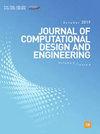齿轮制造质量对一对聚合物齿轮的机械和热反应的影响
IF 4.8
2区 工程技术
Q1 COMPUTER SCIENCE, INTERDISCIPLINARY APPLICATIONS
引用次数: 0
摘要
齿轮制造质量会影响啮合齿轮之间的负载分担以及沿齿宽的负载分布。本研究旨在探讨齿轮制造质量对聚合物齿轮对的机械和热状态的影响,以及由此对其使用寿命的影响。研究发现,几何质量参数的偏差,即齿廓和齿距,对齿轮的应力(齿根和齿面)状态有很大影响。导程偏差对 Q12 至 Q10 质量等级的影响最为明显,根据载荷的不同,当齿轮质量从 Q12 提高到 Q10 时,应力降低了 30-80%。将质量等级从 Q10 提高到 Q8 并没有显著改善载荷分布,观察到的应力降低幅度为 5-20%。在节距偏差方面也发现了类似的趋势,同样,当质量等级从 Q12 提高到 Q10 时,应力减少最为明显。这项研究揭示了可提高齿轮寿命的最有效变化。事实证明,将齿轮质量等级从 Q12 提高到 Q11 比将齿轮质量从 Q9 提高到 Q8 的效果要大得多。考虑到将齿轮质量从 Q12 提高到 Q11 甚至 Q10 可以通过正确的刀具设计和使用正确的工艺参数进行修正迭代来实现,而将质量从 Q9 提高到 Q8 则更具挑战性。我们提出了一种新的方法来评估齿轮质量对发热量和由此产生的工作温度的影响。所提出的方法可以更准确地预测齿轮副的工作温度。本文章由计算机程序翻译,如有差异,请以英文原文为准。
The effect of gear-manufacturing quality on the mechanical and thermal responses of a polymer-gear pair
Gear-manufacturing quality affects the load sharing between the meshing gears as well as the load distribution along the width of the tooth. This study aims to investigate the effect of gear-manufacturing quality on the mechanical and thermal states of polymer-gear pairs and consequently on their lifetime. The deviations of the geometric quality parameters, i.e., the lead profile and pitch, were found to have a substantial effect on the stress (root and flank) state of the gear. The effect of the lead deviation was found to be most pronounced for the quality grades Q12 to Q10, where depending on the load, a 30–80% stress reduction was observed when improving the gear quality from Q12 to Q10. Improving the quality from Q10 to Q8 did not lead to a substantial improvement in the load distribution and the observed stress reduction was in range of 5–20%. Similar trends were found for the pitch deviation, where again the most pronounced stress reduction was seen when improving the quality grade from Q12 to Q10. The study reveals where the most effective changes, leading to an increased gear-life, can be achieved. Improving the gear quality grade from Q12 to Q11 proved to have a much more substantial effect than improving the gear quality from Q9 to Q8. Considering that improving the gear quality from Q12 to Q11 or even Q10 can be achieved by a proper tool design and corrective iterations with the right process parameters, while improving the quality from Q9 to Q8 is by far more challenging. A novel methodology is proposed to assess the effect of the gear's quality on the generation of heat and the resulting operational temperature. The proposed methodology enables more accurate prediction of the gear pair's operating temperature.
求助全文
通过发布文献求助,成功后即可免费获取论文全文。
去求助
来源期刊

Journal of Computational Design and Engineering
Computer Science-Human-Computer Interaction
CiteScore
7.70
自引率
20.40%
发文量
125
期刊介绍:
Journal of Computational Design and Engineering is an international journal that aims to provide academia and industry with a venue for rapid publication of research papers reporting innovative computational methods and applications to achieve a major breakthrough, practical improvements, and bold new research directions within a wide range of design and engineering:
• Theory and its progress in computational advancement for design and engineering
• Development of computational framework to support large scale design and engineering
• Interaction issues among human, designed artifacts, and systems
• Knowledge-intensive technologies for intelligent and sustainable systems
• Emerging technology and convergence of technology fields presented with convincing design examples
• Educational issues for academia, practitioners, and future generation
• Proposal on new research directions as well as survey and retrospectives on mature field.
 求助内容:
求助内容: 应助结果提醒方式:
应助结果提醒方式:


